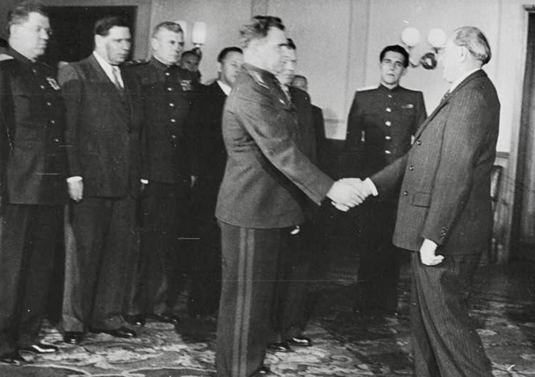The Battle for Stalingrad: The Movie
- Maria A. Kithcart

- Sep 2, 2024
- 2 min read
Updated: Nov 25, 2024

Pictured: On the set of the Soviet feature film "The Battle of Stalingrad." General Chuikov, screenwriter Nikolay Virta, and performer of the role of Chuikov, actor Nikolay Simonov, 1948; movie poster, pamphlet, and cover of the movie script by Virta.
It seems only natural that an epic clash like the Battle for Stalingrad was made into a film, which took place following the Great Patriotic War in 1948 and was released in 1949. While a significant portion of the movie focuses on Stalin’s role, the Military Council of the 62nd Army was also prominently featured in the two-part motion picture. General Chuikov was sought out to be a consultant for the film, as was Field Marshal Paulus. Screenwriter Nikolay Virta served as a war correspondent with Pravda, Izvestia, and Krasnaya Zvezda, and saw the Soviet defense in Leningrad, Stalingrad, and Murmansk first-hand.
Interestingly enough, “The Battle for Stalingrad” was released under the title “The First Front” in the United States and was reviewed in The New York Times on 14 November 1949: “Stalin is pictured as envisioning the plan of the first as a defensive action, and, later as a counter-offensive. Scenes depicting General Chuikov’s decimated battalions’ desperate defense of the gutted and battered bastion, as well as General Rodimtsev’s relief troops’ crossing of the river barrier under fire, are realistically and strikingly staged…”

Battle of Stalingrad film cinema advertising booklet 1949.
In an online article, reviewer Evgeny Belash wrote the following about the cinematography: “In terms of the mass character of the participants, the battle scenes were shot almost on a one-to-one scale—and, perhaps, even surpass the quality of the later ‘followers.’ On the screen, Stalingrad is literally wiped off the ground by bombardments, and then crushed by numerous tanks (one Soviet observer during the attack on 20 August 1942 counted ‘four hundred or five hundred tanks interspersed with vehicles’). But the Soviet units are fighting back to the last man, and this has been noted more than once by the participants in the battles in reality. The battle in the building is shown in one shot: the camera ‘follows’ the fighters from room to room, from floor to floor.
As it should be in a good epic, the workers of the home front, the sailors of the Volga flotilla, and the militia of Stalingrad, who really worked hard and fought heroically, were not forgotten in the ‘Battle of Stalingrad.’ The entire course of the struggle at the operational level was gradually revealed, the topic of precious reserves was raised. It is interesting that here, in contrast to the [movie] ‘Great Break,’ the Soviet commanders are already called by their real names, like Sergeant Pavlov. The general leadership of the hostilities is carried out by Stalin, in Stalingrad itself by Malenkov, then there are Chuikov, Eremenko, Rokossovsky, Rodimtsev, Tolbukhin.”



